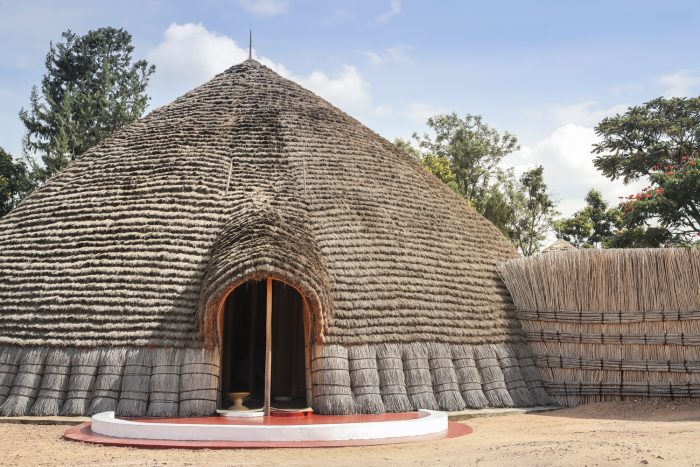[Rwanda] Rukari Royal Palace Museum, Nyanza, Rwanda location stamp
Yann2

Based in Nyanza, 88 km south of Kigali, Rwanda's Capital, this was the residence of King Mutara III Rudahingwa and the Royal Palace that was traditionally built. This Palace offers a glimpse into Rwandan traditional seat of their monarchy, it is an impressive museum, restored to its 19th century state and made entirely with traditional materials.
Recently the long horned Traditional Inyambo cows were also introduced, for cows make up most of Rwandan Culture . On the neighbouring hill of Mwima, one can also visit the burial grounds of King Mutara III and his wife Queen Rosalie Gicanda. source : LandTourTravel
A quote from VisitRwanda
A reconstruction of the traditional royal residence, the King’s Palace is a beautifully-crafted thatched dwelling shaped like a beehive.
In olden times, Nyanza was the heart of Rwanda. According to oral tradition, it was the site of battles and power struggles.
For a long time, the monarchy was mobile, moving the court between various locations. When it eventually settled in one place, Nyanza was the obvious choice. The capital of the kingdom had as many as 2,000 inhabitants, and huts built with the same methods as seen here.

And another, from Bradt Guide :
Nyanza’s main tourist attraction, this ancient hilltop palace marks the site of the old Mwami’s (King’s) home.
The
Rukari Palace Museum
is the top touristic reason for visiting Nyanza; it ’s situated on a hilltop about 2km southwest of the centre, and signposted. The traditional ancient palace of the Mwami has been reconstructed, together with some other buildings, 3–4km away from its original site, beside the newer Western-style palace built for Mwami Rudahigwa Mutara III in 1932.In olden times, Nyanza was the heart of Rwanda and seat of its monarchy, background to the oral tradition of battles and conquests, power struggles and royal intrigues. It is where the German colonisers came, at the end of the 19th century, to visit the Mwami – and contemporary reports tell of the great pomp and ceremony these visits occasioned, as well as the impressive size of the Mwami’s court.
The traditional palace has been carefully reconstructed and maintained, and contains the king’s massive bed as well as various utensils. English- and French-speaking guides are available to relate the history and traditions of the royal court – there is even significance attached to some of the poles supporting the roof; for example, the one at the entrance to the king’s bed is named ‘do not speak of what happens here’ and another conferred sanctuary on anyone touching it.
The newer palace is a typical colonial-era building with its spacious rooms and wide balcony. The Travellers’ Guide above also states: ‘In certain circumstances, and with the permission of the local authorities, he [the Mwami] may be visited at his palace which is built on modern lines, furnished in good taste and richly decorated with trophies in an oriental manner.’
In more recent times, the rundown palace served for several years as the part-time home of Rwanda’s National Ballet (the Intore dancers). Now fully restored, it reopened in May 2008 as a museum whose exhibits relate to the two rulers who lived here during the early to mid 20th century, as well as the more ancient history of the Rwanda Empire. Several original items of royal furniture decorate the interior, and the walls are adorned with monochrome photographs. Other displays depict the palace when it was in use, and chart the history of Rwanda from the 5th century onwards. They’ve also introduced several long-horned Inyambo cattle to the complex and opened the burial site of Mutara III and his wife Queen Rosalie Gicanda (signposted less than 1km away).
More original photos can be seen on Rick Shaw's Travel
Log In
Yann2
Support new Location stamps for underserved Countries?
Dear Slowly friends,
Some of us stamp collectors decided to try to
get Location stamps
- for the many countries which still did not have ANY so far
. Many of us feel that is important, and fair with the Slowly users who live in these countries.Please check this
Reddit topic
, and see a list of currently active proposals. If you think this idea has merit, your support would be very appreciated
.An upvote, a comment in a topic are always welcome, and help ideas become reality. There are more than 25 proposals so far, and some are even in the
IN PROGRESS
stage now!I also wrote a detailed Blog post about
creating nice and successful proposals
for the Slowly Suggestions site. It could help you spruce up your own ideas and presentations here? Thank you !
Nonethewiser
Great job, Yann2! Thank you for the research and the hard work! 🙏 Looks like perfect stamp material to me
Yann2
Nonethewiser: Thank you! I found the construction of this building really interesting, and it is very important to the History of Rwanda.
Most of us who know a bit about the country will remember it from the atrocities, the genocide that happened there, but that is such a sad epoch that I think the local residents would prefer not to have it on a Slowly stamp. (and to be reminded of it when using it).